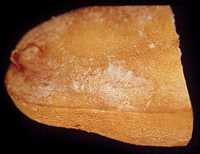Late Blight Managment Begins With Seed Piece Treatments

Should we be thinking about potato late blight management in mid-winter? This disease certainly poses a threat that cannot be ignored during other times of the year. As most of us are aware, potato late blight came back to the attention of North American potato producers with a vengeance in the mid 1990s in the form of new strains that presented a frightening face.
The new strains seemed more aggressive, they spread more quickly, and they were all resistant to metalaxyl, one of the most effective treatments for late blight ever developed. Since those days, late blight seems to have backed off somewhat and hasn’t been quite as bad as before, especially out here in the West. I think I know one reason why this has happened.
When late blight made its infamous comeback, research into all aspects of management was launched across the entire continent. While it might be a bit of an exaggeration, scientists from all over North America pulled together and contributed to a sort of late blight “Manhattan Project.” After several years of intense activity, wherein new chemistries were investigated, new management protocols were conceived, even newer strains were reported upon, and notes were compared every few months, a new understanding of the disease began to take shape.
It seemed as if no stone was left unturned. One important aspect of late blight that received more attention here in North America than it had ever received before was the seedborne component of the dreaded disease.
The Right Conditions
As most of you already know, late blight is very dependent on weather conditions to get started and thrive. Cool, wet conditions are needed and the management response needs to be aggressive when these conditions occur. In order for the disease to get started in a particular production area, however, it must either overwinter in that area or be introduced. There is certainly no shortage of possible sources wherein late blight could overwinter — weed hosts, volunteer potatoes, and cull piles all come immediately to mind. Sources of introduction can include nursery plants (tomatoes) and, probably more importantly, seed potatoes.
One of the outcomes of the intense research into late blight management was a better understanding of just how the disease moves with potato seed tubers. Up until this time, researchers had concentrated their studies on the late-blight-infected tubers in infested seed lots and had paid little attention to the healthy tubers.
Research on infected tubers and how they could give rise to infected plants (and thus start a late blight epidemic) had proven to be pretty much a dead end — the infected plants almost invariably didn’t sprout at all and rotted away. Yet it was obvious that late blight often starts from infested seed. What was going on?
The Susceptibility Factor
It turns out that the new, emerging sprouts on the healthy tubers and the freshly cut surfaces of healthy seed pieces are very susceptible to late blight infection. Whole seed tubers or cut seed pieces infected just before planting are much more likely to produce plants that emerge and have one or more infected stems than are previously infected tubers or seed pieces. The infected seed tubers in the lot, while seldom producing viable plants, still play an important role.
During the time that seed potatoes are warming up prior to planting activities, the late blight organism is likewise waking up within the infected tubers and producing sporangia. While cutting and handling, the inevitable mixing of healthy and diseased tubers spreads these sporangia far and wide, inoculating healthy tubers and cut seed pieces and a new cycle of disease is initiated.
The solution? Seed piece treatments effective against late blight were identified and have come intowidespread usage all across North America. The true nature of the seedborne aspect of late blight was worked out by Dr. Ken Deahl of USDA’s Agricultural Research Service in Beltsville, MD, (healthy sprouts) and Dr. Dave Lambert at the University of Maine (cut seed). A national awareness campaign was initiated and carried through by Dr. Mary Powelson at Oregon State University and her colleague Dr. Debra Inglis at Washington State University. The result of their efforts on seed and the research into other aspects of the disease by the dozens of other scientists across North America, who were part of the late blight team, has been a true success story.
So, even though it is still mid-winter, this isn’t a bad time to be thinking about late blight management. Let’s keep this disease in check. Plan on using a seed piece treatment that is effective against late blight on your seed next year. If the disease doesn’t get an early start next season, it will be that much easier to manage.










